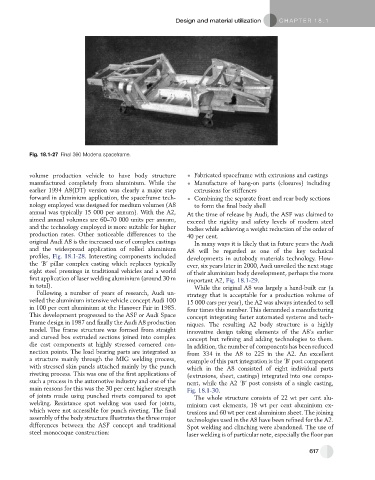Page 606 - Automotive Engineering Powertrain Chassis System and Vehicle Body
P. 606
Design and material utilization C HAPTER 18.1
Fig. 18.1-27 Final 360 Modena spaceframe.
volume production vehicle to have body structure Fabricated spaceframe with extrusions and castings
manufactured completely from aluminium. While the Manufacture of hang-on parts (closures) including
earlier 1994 A8(DT) version was clearly a major step extrusions for stiffeners
forward in aluminium application, the spaceframe tech- Combining the separate front and rear body sections
nology employed was designed for medium volumes (A8 to form the final body shell
annual was typically 15 000 per annum). With the A2, At the time of release by Audi, the ASF was claimed to
aimed annual volumes are 60–70 000 units per annum, exceed the rigidity and safety levels of modern steel
and the technology employed is more suitable for higher bodies while achieving a weight reduction of the order of
production rates. Other noticeable differences to the 40 per cent.
original Audi A8 is the increased use of complex castings In many ways it is likely that in future years the Audi
and the widespread application of rolled aluminium A8 will be regarded as one of the key technical
profiles, Fig. 18.1-28. Interesting components included developments in autobody materials technology. How-
the ‘B’ pillar complex casting which replaces typically ever, six years later in 2000, Audi unveiled the next stage
eight steel pressings in traditional vehicles and a world of their aluminium body development, perhaps the more
first application of laser welding aluminium (around 30 m important A2, Fig. 18.1-29.
in total). While the original A8 was largely a hand-built car (a
Following a number of years of research, Audi un- strategy that is acceptable for a production volume of
veiled the aluminium intensive vehicle concept Audi 100 15 000 cars per year), the A2 was always intended to sell
in 100 per cent aluminium at the Hanover Fair in 1985. four times this number. This demanded a manufacturing
This development progressed to the ASF or Audi Space concept integrating faster automated systems and tech-
Frame design in 1987 and finally the Audi A8 production niques. The resulting A2 body structure is a highly
model. The frame structure was formed from straight innovative design taking elements of the A8’s earlier
and curved box extruded sections joined into complex concept but refining and adding technologies to them.
die cast components at highly stressed cornered con- In addition, the number of components has been reduced
nection points. The load bearing parts are integrated as from 334 in the A8 to 225 in the A2. An excellent
a structure mainly through the MIG welding process, example of this part integration is the ‘B’ post component
with stressed skin panels attached mainly by the punch which in the A8 consisted of eight individual parts
riveting process. This was one of the first applications of (extrusions, sheet, castings) integrated into one compo-
such a process in the automotive industry and one of the nent, while the A2 ‘B’ post consists of a single casting,
main reasons for this was the 30 per cent higher strength Fig. 18.1-30.
of joints made using punched rivets compared to spot The whole structure consists of 22 wt per cent alu-
welding. Resistance spot welding was used for joints, minium cast elements, 18 wt per cent aluminium ex-
which were not accessible for punch riveting. The final trusions and 60 wt per cent aluminium sheet. The joining
assembly of the body structure illustrates the three major technologies used in the A8 have been refined for the A2.
differences between the ASF concept and traditional Spot welding and clinching were abandoned. The use of
steel monocoque construction: laser welding is of particular note, especially the floor pan
617

